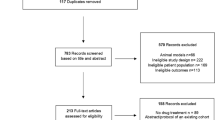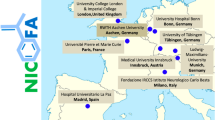Abstract
Friedreich ataxia is characterised by slowly progressive neurodegeneration and cardiomyopathy. Currently, no treatments have been proven to delay, prevent, or reverse the inexorable decline that occurs in this condition; however, several pharmaceutical agents are undergoing clinical assessment. Because initial beneficial therapies are likely to slow disease progression rather than reverse morbidity, the need for accurate measurement tools that will detect such subtle benefits is critical. The impact of Friedreich ataxia on the nervous system has been assessed largely through the use of rating scales and functional composite measures, and a number of patientreported outcome measures in Friedreich ataxia have been studied. However, on the basis of published reports on the performance of these measures, none clearly stands out as the best for use in clinical trials. Refinement of existing tools and development of new tools will be needed to maximise the chance of detecting small but clinically significant benefits of therapeutic agents in patients with Friedreich ataxia.
Similar content being viewed by others
References
Delatycki MB, Williamson R, ForrestSM (2000) Friedreich ataxia: an overview.J Med Genet 37:1–8
De Michele G, Perrone F, Filla A,Mirante E, Giordano M, De Placido S,Campanella G (1996) Age of onset, sex,and cardiomyopathy as predictors ofdisability and survival in Friedreich’sdisease: a retrospective study on 119patients. Neurology 47:1260–1264
Voncken M, Ioannou P, Delatycki MB(2004) Friedreich ataxia – update onpathogenesis and possible therapies.Neurogenetics 5:1–8
Fahey MC, Cremer PD, Aw ST, Millist L,Todd MJ, White OB, Halmagyi M,Corben LA, Collins V, Churchyard AJ,Tan K, Kowal L, Delatycki MB (2008)Vestibular, saccadic and fixation abnormalitiesin genetically confirmedFriedreich ataxia. Brain 131:1035–1045
Blaney B, Hewlett N (2007) Dysarthriaand Friedreich’s ataxia: what can intelligibilityassessment tell us? Int J LangCommun Disord 42:19–37
Rance G, Fava R, Baldock H, Chong A,Barker E, Corben L, Delatycki MB(2008) Speech perception ability inindividuals with Friedreich ataxia.Brain 131:2002–2012
Buyse G, Mertens L, Di Salvo G,Matthijs I, Weidemann F, Eyskens B,Goossens W, Goemans N, SutherlandGR, Van Hove JL (2003) Idebenonetreatment in Friedreich’s ataxia: neurological,cardiac, and biochemical monitoring.Neurology 60:1679–1681
Dutka DP, Donnelly JE, Palka P, LangeA, Nunez DJ, Nihoyannopoulos P(2000) Echocardiographic characterizationof cardiomyopathy in Friedreich’sataxia with tissue Dopplerechocardiographically derived myocardialvelocity gradients. Circulation102:1276–1282
Lodi R, Rajagopalan B, Blamire AM,Cooper JM, Davies CH, Bradley JL,Styles P, Schapira AH (2001) Cardiacenergetics are abnormal in Friedreichataxia patients in the absence of cardiacdysfunction and hypertrophy: anin vivo 31P magnetic resonance spectroscopystudy. Cardiovasc Res 52:111–119
Meyer C, Schmid G, Gorlitz S, Ernst M,Wilkens C, Wilhelms I, Kraus PH,Bauer P, Tomiuk J, Przuntek H, MuggeA, Schols L (2007) Cardiomyopathy inFriedreich’s ataxia – assessment by cardiacMRI. Mov Disord 22:1615–1622
Riazi A, Cano SJ, Cooper JM, BradleyJL, Schapira AH, Hobart JC (2006)Coordinating outcomes measurementin ataxia research: do some widelyused generic rating scales tick theboxes? Mov Disord 21:1396–1403
Hobart JC, Cano SJ, Zajicek JP,Thompson AJ (2007) Rating scales asoutcome measures for clinical trials inneurology: problems, solutions, andrecommendations. Lancet Neurol 6:1094–1105
Trouillas P, Takayanagi T, Hallett M,Currier RD, Subramony SH, Wessel K,Bryer A, Diener HC, Massaquoi S,Gomez CM, Coutinho P, Ben HamidaM, Campanella G, Filla A, Schut L,Timann D, Honnorat J, NighoghossianN, Manyam B (1997) InternationalCooperative Ataxia Rating Scale forpharmacological assessment of thecerebellar syndrome. The AtaxiaNeuropharmacology Committee of theWorld Federation of Neurology. J NeurolSci 145:205–211
Storey E, Tuck K, Hester R, Hughes A,Churchyard A (2004) Inter-rater reliabilityof the International CooperativeAtaxia Rating Scale (ICARS). MovDisord 19:190–192
Cano SJ, Hobart JC, Hart PE, KorliparaLV, Schapira AH, Cooper JM (2005)International Cooperative AtaxiaRating Scale (ICARS): appropriate forstudies of Friedreich’s ataxia? MovDisord 20:1585–1591
Ribai P, Pousset F, Tanguy ML, Rivaud-Pechoux S, Le Ber I, Gasparini F,Charles P, Beraud AS, Schmitt M,Koenig M, Mallet A, Brice A, Durr A(2007) Neurological, cardiological, andoculomotor progression in 104 patientswith Friedreich ataxia duringlong-term follow-up. Arch Neurol64:558–564
Artuch R, Aracil A, Mas A, Colome C,Rissech M, Monros E, Pineda M (2002)Friedreich’s ataxia: idebenone treatmentin early stage patients. Neuropediatrics33:190–193
Di Prospero NA, Baker A, Jeffries N,Fischbeck KH (2007) Neurologicaleffects of high-dose idebenone in patientswith Friedreich’s ataxia: a randomised,placebo-controlled trial.Lancet Neurol 6:878–886
Mariotti C, Solari A, Torta D, Marano L,Fiorentini C, Di Donato S (2003)Idebenone treatment in Friedreichpatients: one-year-long randomizedplacebo-controlled trial. Neurology60:1676–1679
Pineda M, Arpa J, Montero R, Aracil A,Dominguez F, Galvan M, Mas A,Martorell L, Sierra C, Brandi N, Garcia-Arumi E, Rissech M, Velasco D, CostaJA, Artuch R (2008) Idebenone treatmentin paediatric and adult patientswith Friedreich ataxia: long-term follow-up. Eur J Paediatr Neurol 12:470–475
Boddaert N, Le Quan Sang KH, RotigA, Leroy-Willig A, Gallet S, Brunelle F,Sidi D, Thalabard JC, Munnich A,Cabantchik ZI (2007) Selective ironchelation in Friedreich ataxia: biologicand clinical implications. Blood 110:401–408
Subramony SH, May W, Lynch D,Gomez C, Fischbeck K, Hallett M,Taylor P, Wilson R, Ashizawa T (2005)Measuring Friedreich ataxia: interraterreliability of a neurologic rating scale.Neurology 64:1261–1262
Fahey MC, Corben L, Collins V,Churchyard AJ, Delatycki MB (2007)How is disease progress in Friedreich’sataxia best measured? A study of fourrating scales. J Neurol Neurosurg Psychiatry78:411–413
Schmitz-Hubsch T, du Montcel ST,Baliko L, Berciano J, Boesch S, DepondtC, Giunti P, Globas C, Infante J, KangJS, Kremer B, Mariotti C, Melegh B,Pandolfo M, Rakowicz M, Ribai P, RolaR, Schols L, Szymanski S, van deWarrenburg BP, Durr A, Klockgether T,Fancellu R (2006) Scale for the assessmentand rating of ataxia: developmentof a new clinical scale. Neurology66:1717–1720
Weyer A, Abele M, Schmitz-Hubsch T,Schoch B, Frings M, Timmann D,Klockgether T (2007) Reliability andvalidity of the scale for the assessmentand rating of ataxia: a study in 64ataxia patients. Mov Disord 22:1633–1637
Boesch S, Sturm B, Hering S, GoldenbergH, Poewe W, Scheiber-MojdehkarB (2007) Friedreich’s ataxia: clinicalpilot trial with recombinant humanerythropoietin. Ann Neurol 62:521–524
Fischer JS, Rudick RA, Cutter GR,Reingold SC (1999) The Multiple SclerosisFunctional Composite Measure(MSFC): an integrated approach to MSclinical outcome assessment. NationalMS Society Clinical Outcomes AssessmentTask Force. Mult Scler 5:244–250
Cutter GR, Baier ML, Rudick RA,Cookfair DL, Fischer JS, Petkau J,Syndulko K, Weinshenker BG, Antel JP,Confavreux C, Ellison GW, Lublin F,Miller AE, Rao SM, Reingold S,Thompson A, Willoughby E (1999)Development of a multiple sclerosisfunctional composite as a clinical trialoutcome measure. Brain 122:871–882
Balcer LJ, Baier ML, Cohen JA,Kooijmans MF, Sandrock AW, Nano-Schiavi ML, Pfohl DC, Mills M, BowenJ, Ford C, Heidenreich FR, Jacobs DA,Markowitz CE, Stuart WH, Ying GS,Galetta SL, Maguire MG, Cutter GR(2003) Contrast letter acuity as a visualcomponent for the Multiple SclerosisFunctional Composite. Neurology 61:1367–1373
Lynch DR, Farmer JM, Wilson RL,Balcer LJ (2005) Performance measuresin Friedreich ataxia: potentialutility as clinical outcome tools. MovDisord 20:777–782
Fahey MC, Corben LA, Collins V,Churchyard AJ, Delatycki MB (2007)The 25-foot walk velocity accuratelymeasures real world ambulation inFriedreich ataxia. Neurology 68:705–706
Amato MP, Portaccio E (2007) Clinicaloutcome measures in multiple sclerosis.J Neurol Sci 259:118–122
Lynch DR, Farmer JM, Tsou AY,Perlman S, Subramony SH, Gomez CM,Ashizawa T, Wilmot GR, Wilson RB,Balcer LJ (2006) Measuring Friedreichataxia: complementary features ofexamination and performance measures.Neurology 66:1711–1716
Babady NE, Carelle N, Wells RD,Rouault TA, Hirano M, Lynch DR,Delatycki MB, Wilson RB, Isaya G,Puccio H (2007) Advancements in thepathophysiology of Friedreich’s ataxiaand new prospects for treatments. MolGenet Metab 92:23–35
Atkinson MJ, Lennox RD (2006)Extending basic principles of measurementmodels to the design and validationof Patient Reported Outcomes.Health Qual Life Outcomes 4:65
Meyers AR, Gage H, Hendricks A(2000) Health-related quality of life inneurology. Arch Neurol 57:1224–1227
Ware JE Jr, Sherbourne CD (1992) TheMOS 36-item short-form health survey(SF-36) I. Conceptual framework anditem selection. Medical Care 30:473–483
Epstein E, Farmer JM, Tsou A, PerlmanS, Subramony SH, Gomez CM,Ashizawa T, Wilmot GR, Mathews K,Wilson RB, Balcer LJ, Lynch DR (2008)Health related quality of life measuresin Friedreich ataxia. J Neurol Sci 272:123–128
Wilson CL, Fahey MC, Corben LA,Collins VR, Churchyard AJ, Lamont PJ,Delatycki MB (2007) Quality of life inFriedreich ataxia: what clinical, socialand demographic factors are important?Eur J Neurol 14:1040–1047
Food and Drug Administration (USA)(2006) Guidance for industry. Patientreportedoutcome measures: use inmedical product development tosupport labeling claims. Available at:http://www.fda.gov/cber/gdlns/prolbl.pdf (accessed 24 June, 2008)
Author information
Authors and Affiliations
Corresponding author
Rights and permissions
About this article
Cite this article
Delatycki, M.B. Evaluating the progression of Friedreich ataxia and its treatment. J Neurol 256 (Suppl 1), 36–41 (2009). https://doi.org/10.1007/s00415-009-1007-y
Issue Date:
DOI: https://doi.org/10.1007/s00415-009-1007-y




